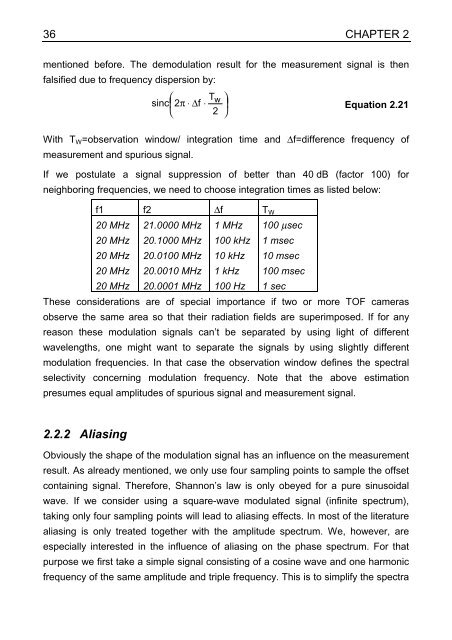3D Time-of-flight distance measurement with custom - Universität ...
3D Time-of-flight distance measurement with custom - Universität ...
3D Time-of-flight distance measurement with custom - Universität ...
Create successful ePaper yourself
Turn your PDF publications into a flip-book with our unique Google optimized e-Paper software.
36 CHAPTER 2<br />
mentioned before. The demodulation result for the <strong>measurement</strong> signal is then<br />
falsified due to frequency dispersion by:<br />
⎛ T ⎞<br />
sinc⎜2π<br />
⋅ ∆f<br />
⋅<br />
w<br />
⎟<br />
Equation 2.21<br />
⎝ 2 ⎠<br />
With TW=observation window/ integration time and ∆f=difference frequency <strong>of</strong><br />
<strong>measurement</strong> and spurious signal.<br />
If we postulate a signal suppression <strong>of</strong> better than 40 dB (factor 100) for<br />
neighboring frequencies, we need to choose integration times as listed below:<br />
f1 f2 ∆f TW<br />
20 MHz 21.0000 MHz 1 MHz 100 µsec<br />
20 MHz 20.1000 MHz 100 kHz 1 msec<br />
20 MHz 20.0100 MHz 10 kHz 10 msec<br />
20 MHz 20.0010 MHz 1 kHz 100 msec<br />
20 MHz 20.0001 MHz 100 Hz 1 sec<br />
These considerations are <strong>of</strong> special importance if two or more TOF cameras<br />
observe the same area so that their radiation fields are superimposed. If for any<br />
reason these modulation signals can’t be separated by using light <strong>of</strong> different<br />
wavelengths, one might want to separate the signals by using slightly different<br />
modulation frequencies. In that case the observation window defines the spectral<br />
selectivity concerning modulation frequency. Note that the above estimation<br />
presumes equal amplitudes <strong>of</strong> spurious signal and <strong>measurement</strong> signal.<br />
2.2.2 Aliasing<br />
Obviously the shape <strong>of</strong> the modulation signal has an influence on the <strong>measurement</strong><br />
result. As already mentioned, we only use four sampling points to sample the <strong>of</strong>fset<br />
containing signal. Therefore, Shannon’s law is only obeyed for a pure sinusoidal<br />
wave. If we consider using a square-wave modulated signal (infinite spectrum),<br />
taking only four sampling points will lead to aliasing effects. In most <strong>of</strong> the literature<br />
aliasing is only treated together <strong>with</strong> the amplitude spectrum. We, however, are<br />
especially interested in the influence <strong>of</strong> aliasing on the phase spectrum. For that<br />
purpose we first take a simple signal consisting <strong>of</strong> a cosine wave and one harmonic<br />
frequency <strong>of</strong> the same amplitude and triple frequency. This is to simplify the spectra

















